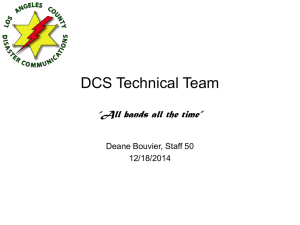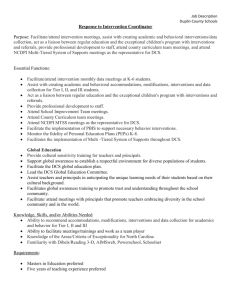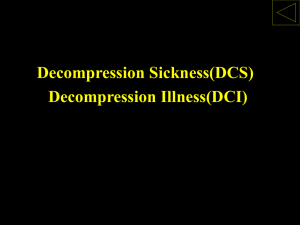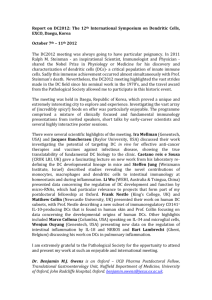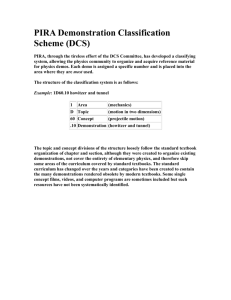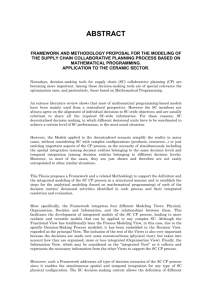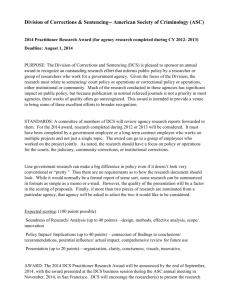Word file (25 KB )
advertisement
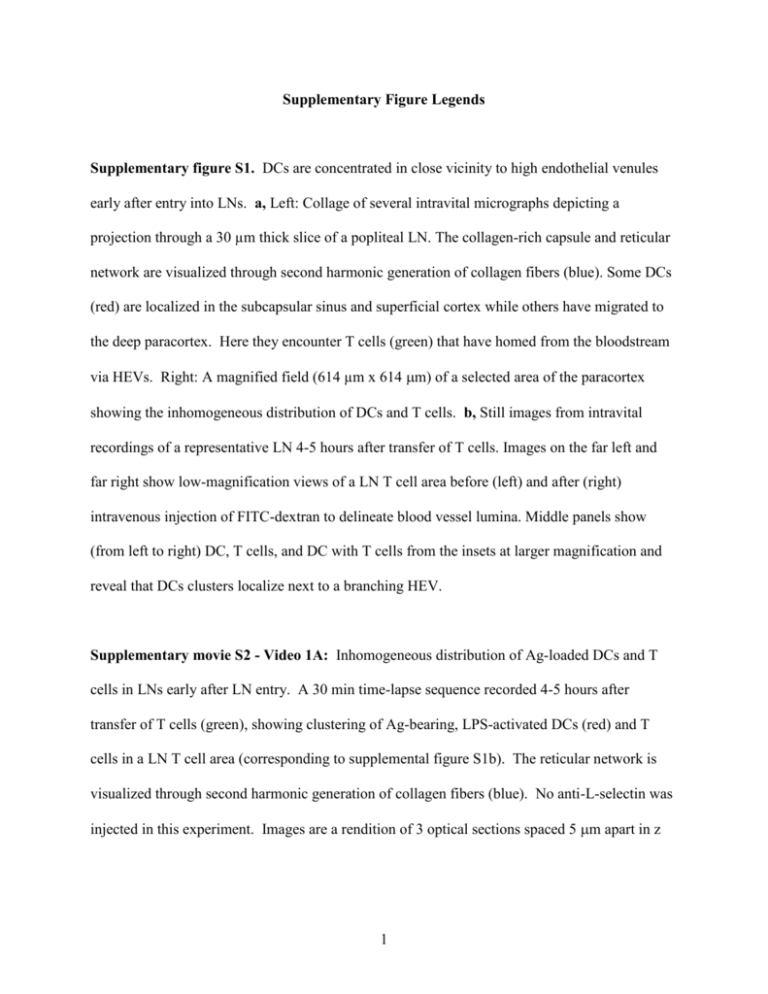
Supplementary Figure Legends Supplementary figure S1. DCs are concentrated in close vicinity to high endothelial venules early after entry into LNs. a, Left: Collage of several intravital micrographs depicting a projection through a 30 µm thick slice of a popliteal LN. The collagen-rich capsule and reticular network are visualized through second harmonic generation of collagen fibers (blue). Some DCs (red) are localized in the subcapsular sinus and superficial cortex while others have migrated to the deep paracortex. Here they encounter T cells (green) that have homed from the bloodstream via HEVs. Right: A magnified field (614 µm x 614 m) of a selected area of the paracortex showing the inhomogeneous distribution of DCs and T cells. b, Still images from intravital recordings of a representative LN 4-5 hours after transfer of T cells. Images on the far left and far right show low-magnification views of a LN T cell area before (left) and after (right) intravenous injection of FITC-dextran to delineate blood vessel lumina. Middle panels show (from left to right) DC, T cells, and DC with T cells from the insets at larger magnification and reveal that DCs clusters localize next to a branching HEV. Supplementary movie S2 - Video 1A: Inhomogeneous distribution of Ag-loaded DCs and T cells in LNs early after LN entry. A 30 min time-lapse sequence recorded 4-5 hours after transfer of T cells (green), showing clustering of Ag-bearing, LPS-activated DCs (red) and T cells in a LN T cell area (corresponding to supplemental figure S1b). The reticular network is visualized through second harmonic generation of collagen fibers (blue). No anti-L-selectin was injected in this experiment. Images are a rendition of 3 optical sections spaced 5 m apart in z 1 corresponding to a 10 m thick volume of the LN. Scale bar = 25 m. Time is shown in minutes and seconds. Events are accelerated 225x over real-time. Supplementary movie S3 - Video 1B: DCs cluster around HEV early after LN entry. A 1 min sequence from the same experiment as in video 1A, recorded during i.v.-injection of FITCdextran (yellow-green) to delineate blood vessels. Rapid filling of all vessels indicates adequate perfusion of the LN preparation. Note that DCs (red) preferentially localized along the branched HEV in the center of the field of view (blood flow from top to bottom). The reticular network is visualized through second harmonic generation of collagen fibers (blue). Images represent one optical section through the LN. Scale bar = 50 m. Time is shown in seconds. Events are accelerated 9x over real-time. Supplementary movie S4 - Video 2: Homogenous distribution of DCs and rapid T cell migration in LNs late after LN entry. Low magnification view of a LN T cell area 44h after transfer of T cells (green). The reticular network is visualized through second harmonic generation of collagen fibers (blue). Many Ag-loaded DCs (red) appear to attach to fibers. While DCs have decreased in motility at this time-point, activated T cells migrate at high velocities. Images represent volume renditions of six optical z-section spaced 6 µm apart (total thickness 30 m). Scale bar = 50 m. Time is shown in minutes and seconds. Events are accelerated 225x over real-time. Supplementary movie S5 - Video 3: DC migration and shape change in LNs. Migrated DCs (red) without antigen in a LN T cell area 2 hours after injection of T cells (T cells are not shown 2 for better visual clarity). The imaged volume is 30 m thick. Scale bar = 25 m. Time is shown in minutes and seconds. Events are accelerated 225x over real-time. Supplementary movie S6 - Video 4: Lack of blood flow leads to rapid cessation of T cell and DC migration. For this movie respiratory and cardiovascular arrest was induced by an i.v. overdose of anaesthetic at timepoint 30:00 min. during acquisition of a time-lapse sequence of migrating T cells (green) and DCs (red). The reticular network was visualized through second harmonic generation of collagen fibers (blue). A few minutes after induction of cardiovascular arrest, both DCs and T cells stopped migrating and partly lost their polarized shape. The imaged volume is 30 m thick. Scale bar = 25 m. Time is shown in minutes and seconds. Events are accelerated 450x over real-time. Supplementary movie S7 - Video 5: T cells cover large territories in LNs. This scene corresponds to fig. 2a. T cells (green) are shown migrating in the LN paracortex in the absence of injected DCs. To provide an anatomical landmark, TRITC-dextran (red) was injected i.v. to delineate capillaries. The imaged volume is 25 m thick. Scale bar = 25 m. Time is shown in minutes and seconds. Events are accelerated 225x over real-time. Supplementary movie S8 - Video 6: Short, serial T cell-DC contacts predominate during phase one. This scene shows T cells (green) and antigen-loaded DCs (red) migrating in the vicinity of a venular tree, which was made visible by i.v.-injection of FITC-dextran (green, blood flow from bottom to top). 3.5 hours after T cell entry into the LN (1.5 hours after anti-L-selectin injection), T cells interact only briefly with DCs in the vicinity of HEV. The imaged volume is 3 30 m thick. Scale bars = 25 m. Time is shown in minutes and seconds. Events are accelerated 225x over real-time. Supplementary movie S9 - Video 7: Stable T cell-DC conjugates predominate during phase two. At 10 hours after T cell transfer (8 hours after anti-L-selectin injection), stable conjugates of Ag-loaded DCs (red) with one or several T cells (green) predominate. T cells attach either to the DC’s body or to their dendrites. The reticular network is visualized through second harmonic generation of collagen fibers (blue). The imaged volume is 30 m thick. Scale bar = 10 m. Time is shown in minutes and seconds. Events are accelerated 225x over real-time. Supplementary movie S10 - Video 8: DCs (red) can undergo stable and dynamic interactions with T cells (green) simultaneously. During the transition from phase one to phase two (6h – 7h after T cell transfer), one T cell (*) is stably attached to a DC and is dragged along with the migrating DC, while a second T cell (**) makes two successive short contacts with the same DC (indicated by circles). The imaged volume is 30 m thick. Scale bar = 10 m. Time is shown in minutes and seconds. Events are accelerated 225x over real-time. Supplementary figure S11: Absolute (a) and cumulative (b) contact duration between DO11.10 TCR transgenic CD4+ T cells and peptide-loaded DCs in popliteal lymph nodes. Splenic DCs were incubated with OVA323-339 peptide and injected with 10 ng LPS into a footpad of Balb/c recipient mice. Purified DO11.10 CD4+ T cells were injected i.v. 18h later and their interactions with DCs that had migrated to popliteal LNs were imaged for 30 min. at 3h, 10h and 47h after T cell injection. In these experiments, T cell dwell time was not synchronized by anti-L-selectin 4 injection. Thus, the population of T cells that underwent short-lasting interactions at the 10h time point probably reflects more recent lymph node immigrants displaying phase one-like behavior. Supplementary figure S12: Absolute (a) and cumulative (b) contact duration between P14 TCR transgenic CD8+ T cells and peptide-loaded DCs in popliteal lymph nodes. Splenic DCs were incubated with gp33-41 and injected with 10 ng LPS into a footpad of C57BL/6 recipient mice. Purified P14 CD8+ T cells were injected i.v. 18h later and their interactions with DCs that had migrated to popliteal LNs were imaged for 30 min. at 3h and 10h after T cell injection. In these experiments, T cell dwell time was not synchronized by anti-L-selectin injection. Thus, the population of T cells that underwent short-lasting interactions at the 10h time point probably reflects more recent lymph node immigrants displaying phase one-like behavior. 5
